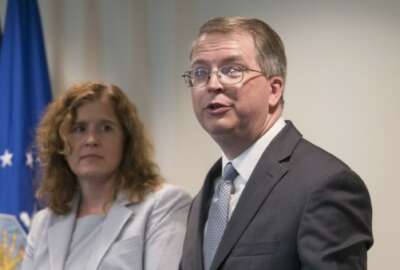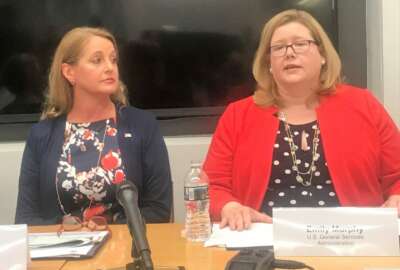
Bureau of the Fiscal Service makes shared services key to modernization
The Bureau of the Fiscal Service has taken on a larger role as a shared service provider as part of Treasury’s plan to transform the state of federal financial...
Best listening experience is on Chrome, Firefox or Safari. Subscribe to Federal Drive’s daily audio interviews on Apple Podcasts or PodcastOne.
The Treasury Department and the Bureau of the Fiscal Service last year disbursed $66 billion in payments for the Defense Department, an arrangement that allows DoD to focus more on its core military mission.
But that’s only part of the agency’s plan to process nearly half a trillion dollars in payments for the Pentagon by the end of fiscal 2022.
Bureau Commissioner Tim Gribben told Federal News Network that some operations will remain within the Department of Defense for security reasons, but said DoD’s deputy chief financial officer has identified 15 programs that Treasury can disburse on behalf of the Pentagon.
So far, Treasury disburses payments for nine of those program offices, and for the remaining six, Gribben said the agency has laid the groundwork of taking over those programs as well.
In taking on a larger shared service role, Gribben said Treasury and the bureau have played a major contributing role in DoD’s goal of someday producing a clean audit opinion.
“What this helps achieve is a better standardization of payment formats, better reporting and reconciliation of fund balances with Treasury, understanding exactly, between the different components of DoD, what payments are being made,” he said in an interview.
The bureau has taken on a larger role as a shared service provider as part of Treasury’s plan to transform the state of federal financial management over a decade.
This five-point strategy, “The Future of Federal Financial Management,” focuses in part on making the bureau a greater provider of shared services, and use the data it collects to provide greater insight to government spending.
The strategy, released in April 2018, outlines five goals:
- Optimize federal disbursing,
- Transform federal collections,
- Strengthen financial reporting,
- Expand services available to agencies,
- Modernize federal financing.
The bureau’s shared service portfolio includes its free Do Not Pay service, which centralizes data to stop fraudulent and improper payments before they’re made.
It also includes its Centralized Receivables Service, which ensures that agencies receive payments that are either current obligations or slightly delinquent payments. Gribben said the bureau expects to expand use of this service to a million transactions by the end of this year.
The bureau and Treasury have also taken steps to meet the Office of Management and Budget’s goals of making the organization a Quality Services Management Office (QSMO) for financial management.
Gribben said the QSMO would set up a marketplace so agencies can buy their core financial management systems through a governmentwide contract vehicle.
The bureau recently submitted its QSMO plan to OMB, received comments back and met with OMB officials to discuss how it addressed those comments.
Gribben said Treasury is in the process of submitting its final implementation plan to OMB. Once designated as the QSMO for financial management, he said Treasury would meet with agencies to discuss their need for these services.
“We do know that of the financial management systems that are in operation, many are end-of-life and [agencies] could use a vehicle that they could procure their systems, knowing that it’s a standardized configuration, and they don’t have to go through the individual procurement process that each agency would have to go through in order to find a new financial system,” Gribben said.
Meanwhile, the departments of Commerce and Homeland Security have already entered the financial management systems marketplace, and have issued solicitations for their services.
Gribben said the bureau regularly meets with DHS and Commerce to discuss their progress.
“We’re hoping that what they learn through their solicitations will help us inform the offerings that will be available on the marketplace for all agencies to be able to enjoy,” Gribben said.
Moving toward modern, data-centric services
Meanwhile, the bureau has taken steps to move from a paper-based organization to a digital agency that leverages its data insights in near-real-time.
This modernization effort requires the bureau to work closely with agencies that include the IRS, the Social Security Administration and other agencies to reduce paper-based processes.
The bureau, for example, still issues 54 million paper checks annually.
Gribben said moving from paper checks to electronic payments would not only cut costs, but it would also make those payments more secure.
“People think that a paper check is more secure, when actually the electronic transactions are a lot more secure than paper,” Gribben said. “People don’t realize how easy it can be to forge a paper check, to change a number on a paper check or divert it from a mailbox.”
To get a better handle of its data, the bureau recently named Justin Marsico as its permanent chief data officer.
Prior to this position, Marsico served as the bureau’s product manager for research and analytics for data transparency, and led efforts to launch “Your Guide to America’s Finances,” which provides governmentwide data visualization of revenue and spending.
As the chief data officer, Marsico will also lead the charge in creating a learning agenda for the bureau, as mandated under the Foundations for Evidence-Based Policymaking Act.
Gribben described the learning agenda as a series of open questions that, if answered through the bureau’s treasure trove of financial data, would help the organization meet its mission in a more cost-effective way.
“That learning agenda within the bureau is what has helped us to be able to remain flexible and transform from a paper-based organization to more of a data-based organization — more electronically focused,” Gribben said. “And that skill set is where you’re really looking through the data to be able to identify anomalies, to be able to identify ways to make payments faster.”
The bureau’s workforce has also gone through this transformation process. In lieu of paper checks, for example, bureau employees spend more time issuing an ATM-card product called Direct Express that allows unbanked Americans to receive benefits from SSA or the Department of Veterans Affairs.
“We are always assessing the current state of the workforce and where we want to be,” Gribben said.
In addition, Gribben said the bureau offers a scholarship program where employees can learn skills that may not apply to their current job, but could help them apply for future jobs.
As part of a focus on improving its customer experience, the bureau has overhauled its landing page for its website, and will next look at how all of its disparate dot-gov websites work together — both those that are internal to government and those seen by the general public.
“Sometimes when you’re looking for data, you can go and find an answer in multiple places, and sometimes you have to find where that place is. We want to make that a better transaction or a better experience for people trying to find Treasury data,” Gribben said.
Next steps for 10-year vision
This spring, the bureau will set its goals for the next 12-18 months, communicate to the CFO community in the summer and then assess progress in the fall. As part of this agenda, Gribben has launched an outreach effort with the 24 largest agencies in the federal government, which fall under the CFO Act.
So far, Gribben said he’s conducted eight of these visits, and has another eight scheduled. The remaining eight, he said, still need to be scheduled.
“The way I’m conducting them, it’s more of a listening session, where I’m talking to them to find out what are their pain points, what are the things that are working well and what are the things that we could help them with,” Gribben said.
Copyright © 2025 Federal News Network. All rights reserved. This website is not intended for users located within the European Economic Area.
Jory Heckman is a reporter at Federal News Network covering U.S. Postal Service, IRS, big data and technology issues.
Follow @jheckmanWFED





